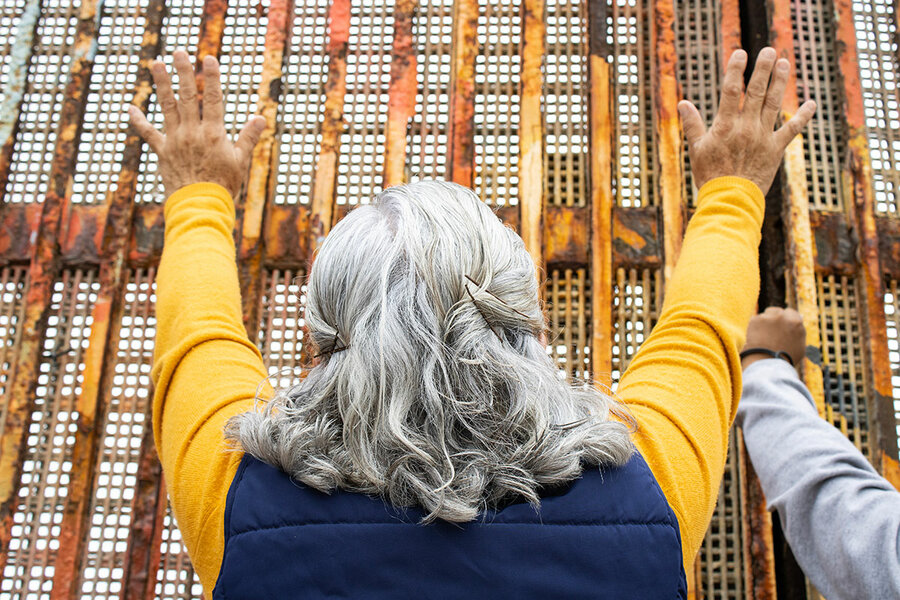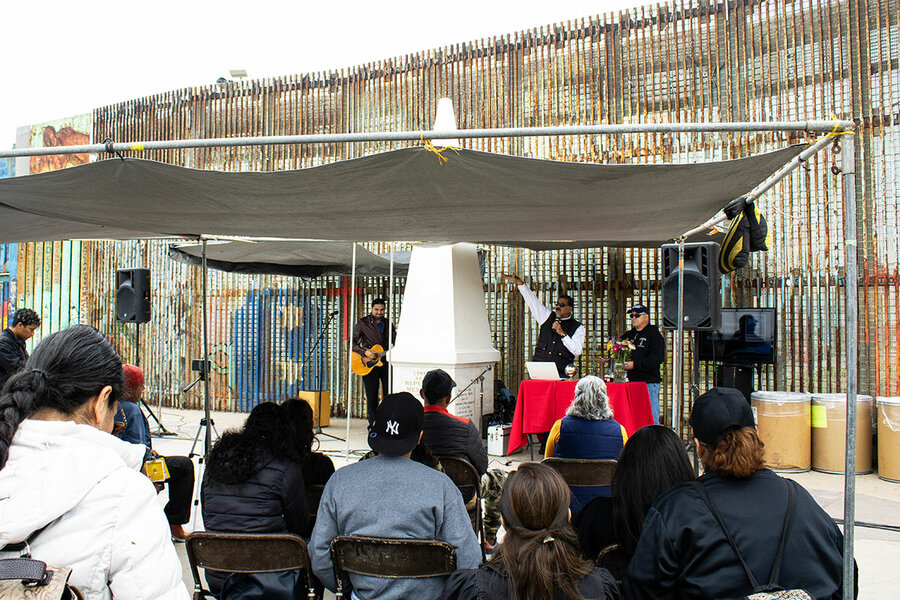US-Mexico border park – a long way from the ‘pinky kiss’
Loading...
| TIJUANA, MEXICO
Locals on both sides of the U.S.-Mexico border have long known Parque de la Amistad, or Friendship Park, as an unofficial international meeting space between San Diego County and Tijuana. Family members without permission to cross once touched fingertips – to “pinky kiss” – through mesh. But access has evolved over the years, and the park is officially closed on the U.S. side. Local activists are protesting a federal construction project of two new replacement fences. They want visits to resume as soon as possible on the San Diego County side.
The Mexico side, however, remains public and vibrant, with photo-snapping tourists, a tended garden, and a muraled stretch of border fence that backdrops the weekly Border Church. The place remains a witness to border policy penned a few thousand miles away and a solace to the lives shaped by that policy. Those who can’t join loved ones on the other side can at least unite in solidarity here.
Why We Wrote This
A story focused onLocals on the U.S.-Mexico border have long known Friendship Park as a space of unity. But times have changed, and the park, which links San Diego County and Tijuana, is under construction – and protest.
It’s an ethos of openness that the Rev. Guillermo Navarrete takes to heart in his open-air church, where congregants gather beneath a white lighthouse.
“I have no wall. I have no roof,” says the Border Church pastor. “My limit,” he says, pointing upward, “is the sky.”
Worshippers murmur prayers near a Tijuana beach, hands pressed on rusted slats. The border fence before them continues toward the roar of waves, ending in the ocean.
Everyone is welcome at the outdoor church on the western end of the U.S.-Mexico border. The service and its setting – the binational Friendship Park – have long lured those with stories of separation and of dashed dreams of America. One of the visitors is Veronica Martinez, whose family lives north of the border.
Extending her palms toward the fence one recent Sunday, she mentally travels: “I just kind of transported myself to the other side.”
Why We Wrote This
A story focused onLocals on the U.S.-Mexico border have long known Friendship Park as a space of unity. But times have changed, and the park, which links San Diego County and Tijuana, is under construction – and protest.
In the 1980s, Ms. Martinez’s Mexican mother crossed the border unlawfully with her as a child to reunite with her father in the United States. The child grew into an adult who started her own family in the U.S. and built a life of her own over three decades there. But Ms. Martinez was never able to change her unauthorized status. Since deciding to visit her mom back in Mexico in 2019 before she died, Ms. Martinez has not been able to legally rejoin her American family.
“It was a big decision between my daughters and my mom,” says Ms. Martinez. “I just want to see them and hug them. ... I feel like I’m drained.” Her clothes match the colors of the country that won’t take her back: red-and-white blouse, blue denim vest.
Locals on both sides of the border have long known Parque de la Amistad, or Friendship Park, as an unofficial international meeting space. Family members without permission to cross once touched fingertips – to “pinky kiss” – through mesh. But access has evolved over the years, and the park is officially closed on the U.S. side. Local activists are protesting a federal construction project of two new replacement fences. They want visits to resume as soon as possible on the San Diego County side.
The Mexico side, however, remains public and vibrant, with photo-snapping tourists, a tended garden, and a muraled stretch of this primary border fence that backdrops the weekly Border Church. The place remains a witness to border policy penned a few thousand miles away, and a solace to the lives shaped by that policy. Those who can’t join loved ones on the other side can at least unite in solidarity here.
It’s an ethos of openness that the Rev. Guillermo Navarrete takes to heart in his open-air church, where congregants gather beneath a white lighthouse.
“I have no wall. I have no roof,” says the Border Church pastor. “My limit,” he says, pointing upward, “is the sky.”
A time capsule of border politics
An overcast sky hovers above Playas de Tijuana, but the threat of rain relents. Mic in hand, Mr. Navarrete leads the interdenominational, bilingual service in the afternoon, synced by audio with a service farther north, not far from the border.
“Gracious God, we thank you. ... Though we are separated by many difficulties, we thank you that you are making us one,” says the Rev. Dr. Seth David Clark, an American pastor. His voice is piped in through speakers from his own Border Church service held outdoors, nearby in San Diego County. He pastors at a Baptist church earlier in the morning.
The park represents a time capsule of border politics – and not just for its boundary marker, a white obelisk, established after the Mexican-American War. In 1971, first lady Pat Nixon, wife of Republican President Richard Nixon, inaugurated the surrounding area on the U.S. side, today known as California’s Border Field State Park, with visions of an international gathering space.
“I hate to see a fence anywhere,” said the first lady, as quoted by the Associated Press. She crossed through a barbed wire fence to greet a crowd on the Mexican side. “I hope there won’t be a fence here very long.”
By the 1990s, however, a Democrat – former President Bill Clinton – began to bolster border security in the area to curb illegal crossings. Friends of Friendship Park convened in 2006 to advocate for more public access to the area, including after a second border barrier was built. The group looks to Peace Arch Historical State Park on the U.S.-Canada border as a model – a landscaped day-use park where visitors to the Washington state side don’t need to bring documents (but passports are recommended).
Friendship Park remains a site of protest and politicking. In 2018 on the California side, it’s where former Attorney General Jeff Sessions announced the Trump administration’s family separation policy.
The federal government, which has spoken with stakeholders, says it closed access to the area in 2019 due to personnel availability and barrier deterioration. Its construction project, scheduled to be completed this summer, calls for replacing primary and secondary partitions in the area with standard steel bollard fencing. The primary fence will include mesh on the north side to prevent the passing through of contraband, according to Jason Givens, spokesperson for Customs and Border Protection. “Visibility through the fence will remain the same,” he writes in an email.
But Friends of Friendship Park objects to the plans.
“In our view, that violates President Biden’s campaign pledge when he said no new wall on the U.S.-Mexico border,” says the Rev. John Fanestil, a San Diegan. The minister is a founding member of Friends of Friendship Park, and began passing Communion across the primary border fence in 2008. Border Church began more formal services three years later. Those on the U.S. side assembled between the primary and secondary walls under Border Patrol’s watch.
The U.S. government says it will resume such visits on the U.S. side, allowing for communication “with friends and family located in Mexico on the other side of the primary barrier as in years past,” according to a government statement in March.
Mr. Fanestil and others consider the construction plans a visual and symbolic affront.
“They’re destroying the cross-border views and the cross-border experience of the space,” he says. “Most people visiting will not even recognize that there is a park.”
Meanwhile, the Sunday tradition continues on the Mexican side. Rocky Hernandez, a deported U.S. veteran, comes early to set up the arrangement of tents and chairs.
“I stopped going to work on Sundays,” says the hairstylist. “Just to come over here and help.”
Others are drawn by a fellowship that welcomes visitors as they are – including asylum-seekers, beachgoers, and people living on the street.
“This is the truly most inclusive church I’ve ever been at, and I love that,” says Carol Clary, an American who retired in Tijuana. She doles out drops of hand sanitizer and welcomes those in line for a post-service lunch, typically tacos or tostadas.
Yessenia claps along to a song on a guitar. The migrant from Guatemala says she’s grateful to receive donated clothes and toys offered at the gathering.
“I know Brother Guillermo well, and he’s a good person,” she says, her ponytailed daughters by her side.
Ms. Martinez, here alone, regards the waves where the border fence ends. Desperate for her daughters, she once considered crossing in low tide. Hope held her back. She recently learned that one of her daughters plans to visit soon.
“You have to be very patient,” she says. Her eyes swell with oceans of their own.











